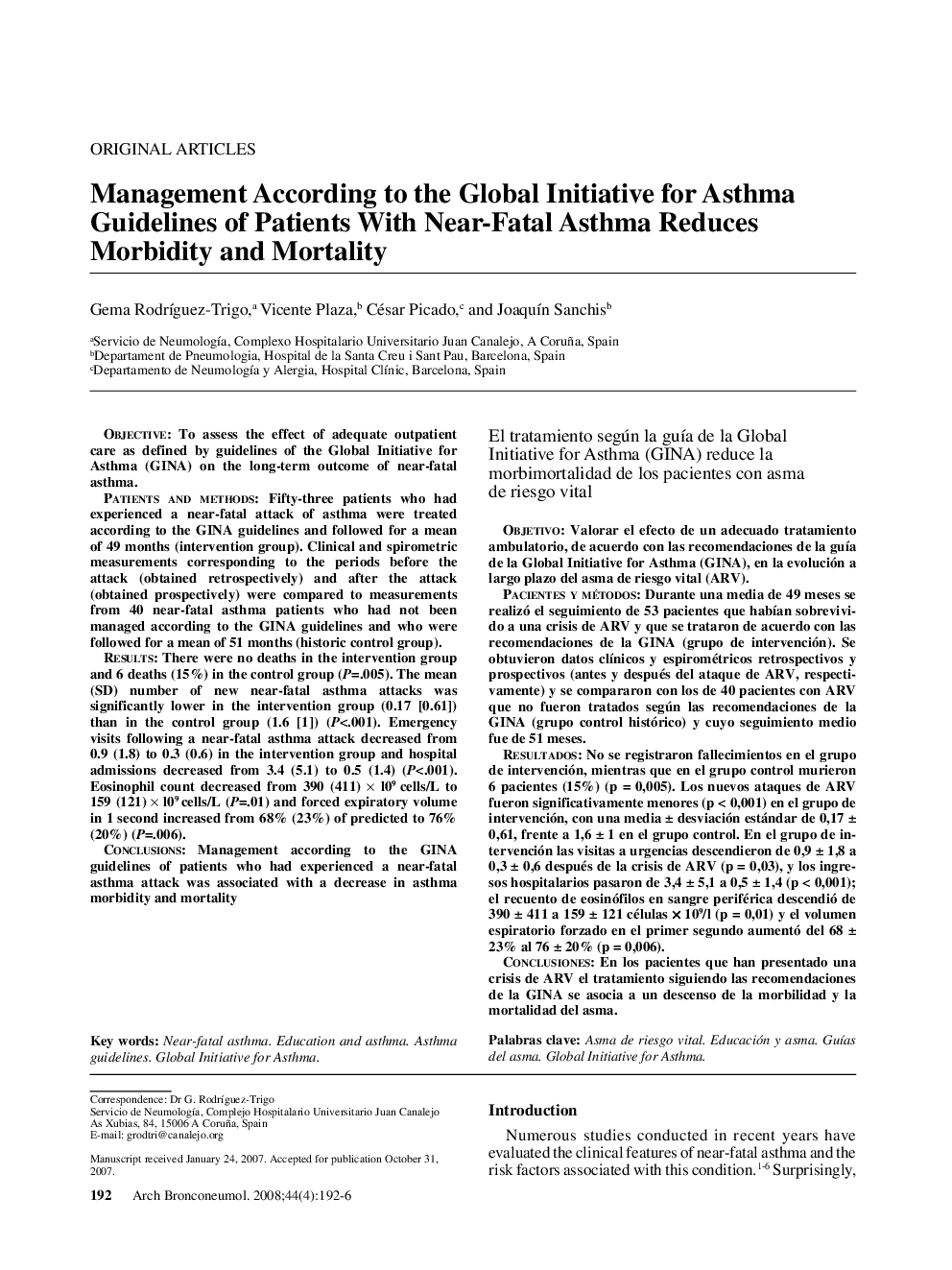| کد مقاله | کد نشریه | سال انتشار | مقاله انگلیسی | نسخه تمام متن |
|---|---|---|---|---|
| 4206201 | 1279966 | 2008 | 5 صفحه PDF | دانلود رایگان |

ObjectiveTo assess the effect of adequate outpatient care as defined by guidelines of the Global Initiative for Asthma (GINA) on the long-term outcome of near-fatal asthma.Patients and methodsFifty-three patients who had experienced a near-fatal attack of asthma were treated according to the GINA guidelines and followed for a mean of 49 months (intervention group). Clinical and spirometric measurements corresponding to the periods before the attack (obtained retrospectively) and after the attack (obtained prospectively) were compared to measurements from 40 near-fatal asthma patients who had not been managed according to the GINA guidelines and who were followed for a mean of 51 months (historic control group).ResultsThere were no deaths in the intervention group and 6 deaths (15%) in the control group (P=.005). The mean (SD) number of new near-fatal asthma attacks was significantly lower in the intervention group (0.17 [0.61]) than in the control group (1.6 [1]) (P<.001). Emergency visits following a near-fatal asthma attack decreased from 0.9 (1.8) to 0.3 (0.6) in the intervention group and hospital admissions decreased from 3.4 (5.1) to 0.5 (1.4) (P<.001). Eosinophil count decreased from 390 (411) × l09 cells/L to 159 (121) × l09 cells/L (P=.01) and forced expiratory volume in 1 second increased from 68% (23%) of predicted to 76% (20%) (P=.006).ConclusionsManagement according to the GINA guidelines of patients who had experienced a near-fatal asthma attack was associated with a decrease in asthma morbidity and mortality
ObjetivoValorar el efecto de un adecuado tratamiento ambulatorio, de acuerdo con las recomendaciones de la guía de la Global Initiative for Asthma (GINA), en la evolución a largo plazo del asma de riesgo vital (ARV).Pacientes y métodosDurante una media de 49 meses se realizó el seguimiento de 53 pacientes que habían sobrevivido a una crisis de ARV y que se trataron de acuerdo con las recomendaciones de la GINA (grupo de intervención). Se obtuvieron datos clínicos y espirométricos retrospectivos y prospectivos (antes y después del ataque de ARV, respectivamente) y se compararon con los de 40 pacientes con ARV que no fueron tratados según las recomendaciones de la GINA (grupo control histórico) y cuyo seguimiento medio fue de 51 meses.ResultadosNo se registraron fallecimientos en el grupo de intervención, mientras que en el grupo control murieron 6 pacientes (15%) (p = 0,005). Los nuevos ataques de ARV fueron significativamente menores (p < 0,001) en el grupo de intervención, con una media ± desviación estándar de 0,17 ± 0,61, frente a 1,6 ± 1 en el grupo control. En el grupo de intervención las visitas a urgencias descendieron de 0,9 ± 1,8 a 0,3 ± 0,6 después de la crisis de ARV (p = 0,03), y los ingresos hospitalarios pasaron de 3,4 ± 5,1 a 0,5 ± 1,4 (p < 0,001); el recuento de eosinófilos en sangre periférica descendió de 390 ± 411 a 159 ± 121 células × 109/l (p = 0,01) y el volumen espiratorio forzado en el primer segundo aumentó del 68 ± 23% al 76 ± 20% (p = 0,006).ConclusionesEn los pacientes que han presentado una crisis de ARV el tratamiento siguiendo las recomendaciones de la GINA se asocia a un descenso de la morbilidad y la mortalidad del asma.
Journal: Archivos de Bronconeumología ((English Edition)) - Volume 44, Issue 4, 2008, Pages 192-196